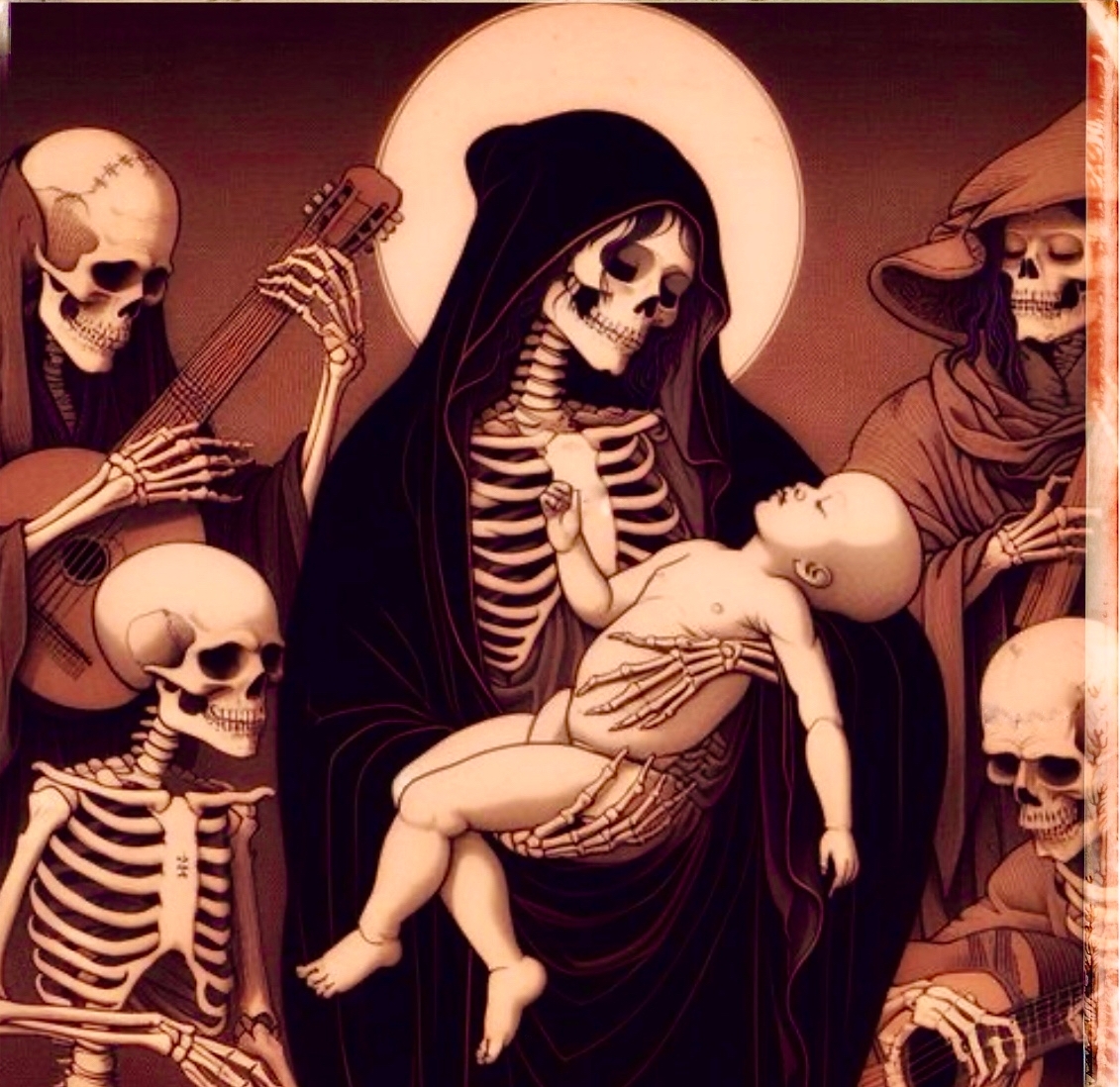CRADLING EXISTENTIAL DREAD IN SONG
Hush little baby, don’t say a word.
And so begins the well-known lullaby “Hush Little Baby” that goes on to say a great many words. As a lullaby, it is melodically soothing, though the lyrics betray a note of parental desperation as it offers rewards to the baby for good behavior and forewarns of disappointment. Indeed, this old lullaby is almost prescient in its expectation that every “gift” aimed at bribing the crying baby into silence carries within itself the potentiality of deterioration, from the mockingbird that won’t sing to the rocking horse that won’t rock.
The song ends with the warning that even the baby-laden horse and cart is capable of collapsing in a heap, tossing the infant onto the cobblestones. But don’t worry: the parents will still love their broken child.
Many of our most well-known lullabies veer into morbid territory. Anyone familiar with lullabies and nursery rhymes from the English-speaking world must automatically think of treetop tots falling from broken boughs, or London Bridge making an awful splash as it crashes into the Thames. Ashes, ashes, all fall down.
It only gets worse.
Not only do we have the above mentioned grimness of classic Anglo-American childhood chants, but apparently parents from seemingly every culture around the world still resort to “boogeyman” threats so as to tame the wildness out of their wide-awake progeny.
To some degree the contemporary community of Horror writers and filmmakers around the globe have aided in disseminating the notion of the punishing boogeyman. These creative souls even helped save a Germanic boogeyman from obscurity by re-introducing modern audiences to the legend of Krampus, the goat-headed demonic sidekick of Saint Nicholas tasked with doling out punishment for the brats on Santa’s “naughty list” (Tauber; Sidhu).
But if Krampus is a once-a-year threat, consider how kids in Brazil must feel when they are threatened by their parents every evening with the arrival of Cuca, the hungry alligator witch who is always on the lookout for wide-awake weans. Meanwhile, half a world away we see that for thousands of years Javanese parents have been frightening frowns from infant faces with songs about the giant who carries away crying babies (Okrent).
Boogeyman threats like these make evolutionary sense when you consider recent findings that suggest crocodiles are especially attuned to the distress cries of juvenile primates: “the more anxious the cry, the more interested the crocs become” (Rains). Or as a Russian lullaby intones: the wolf is always at the door.
But what’s to be done when the wolf is the child’s own mother or father?
Just ask the children from Italy, Scotland, Turkey, and elsewhere whose caregivers have intoned the parental right to simply hand the wakeful child over to whatever hungry monster is hiding beneath the bed (Okrent).
Could it be that this kind of parental meanness is more common than we realize?
Psychiatrists have suggested that lullabies can go extremely dark because the relationship between child and caregiver is uniquely intimate, and therefore the song is the parent’s private conversation with herself or himself. While enjoying the comfort of having a healthy child, the parental psyche is also forever aware that in the space of a heartbeat everything can go wrong. Within the lullaby a worried caregiver can sing the unsung, speak the unspeakable, and give voice to the morose emotions that society deems antisocial (Marder).
Yes, the message of human frailty is unpopular — even taboo — in the “feel good” societies that our capitalist-industrialist economies have shaped for us. We collectively practice a stubborn denial of inevitabilities, and find it especially impolite to speak frankly about dying (Irish Hospice Foundation).
Death is only an acceptable topic when it is dressed in spectacle, the sort of costuming that our entertainment and news media use to help us pretend that the thanatotic tendencies of terrorists, tyrants, and trolls are not the same violent potentialities that lie within each of us.
But the ability to lash out is baked into our survival instinct (Kalbitzer et al.), endowing each of us with a capacity for extreme violence, even as society encourages us to deny the beast within.
Unfortunately, this refusal to acknowledge our shadow potentialities can stunt us as individuals, and in the worst case scenarios open the door to vicious tendencies finding expression in the harming of ourselves and others. The solution to this dilemma, says psychoanalyst Carl Jung (1875-1961), is neither suppression nor expression, but integration.
Jung’s approach to psychological health encourages a lifelong process of “individuation” by which one’s lived experiences as a social being and one’s private experiences as an imaginative mind can find balance, beginning with an acknowledgment of both the light and dark aspects of the human psyche. By the time we reach the status of “elder,” each of us should have become capable of combining within ourselves “the conscious and unconscious, the rational and irrational, the feminine and masculine, matter and spirit” (Leigh 97).
The cultural products of our creative storytellers have a good deal to contribute to the individuation processes. Stories are a form of schooling and mirroring, offering themselves up as public lectures and private dreams. We assimilate these narratives in all their forms — as fine art, as printed fictions, as projected films — and cradle them within the privacy of our minds, re-shaping them into personal values that guide us toward wholeness as healthily individuated subjects.
How much stronger is this process when the art form is music?
Archaeological findings suggest that humans have been making musical instruments for at least 40,000 years, and given that evidence of “fire control” dates as far back as 790,000 years, it is not unimaginable that our ancient ancestors sat around a campfire and listened in reverence to the life-shaping chant songs of tribal shamans (Killin 4).
Modern psychological studies have teased out a number of functions that music provides listeners, ranging from the social to the deeply private (Schäfer et al., 4-6). Music can bond people into nations and divide them in war. It can excite and entice, or calm and comfort. Music and song can help us know our own feelings. We call upon when we celebrate and mourn, worship and blaspheme, wake up and fall asleep, identify with and separate from others. And of course, music is there to help us tell stories about ourselves and the worlds we inhabit.
The lullaby can be our first exposure to musical storytelling. Indeed, the song can be heard even when we are still within the vibrating waters of the maternal womb’s final trimester (Partanen et al.).
The song grows stronger as we grow older. Like the spoonful of sugar that puts the pop in Mary’s medicine, rhythmically enriched story helps children comprehend and remember even the most complex concepts (Yoon and Kim). As a “whole brain” experience music also enhances the child’s ability to “feel” and be more emotionally receptive to the story being told (Janata, ctd. Crowther).
How powerful, then, is the message of existential menace that translates through the musical soothe of the lullaby? Can there be anything more “real” than the caretaker’s realization of the beloved child’s mortality? And honestly, what can be darker than singing about death to a squalling sprog?
Well, there’s always the next step: the nursery rhyme as self-disciplinary storytelling. A globalized publishing industry has encouraged this phenomenon with easily available print editions of grim fairy tales and nursery crimes. Think only of those hints of mortality being repeated rhythmically during playtime — such as the hypnotic “ring around the rosie” dance (a song about plague), the rabid audacity of blind mice, or the guilty pleasure of watching Humpty Dumpty get the ultimate shellacking. Once children decode the magic of reading, these darksome ditties are repeated so often that they become part of the adult psychic repertoire.
How much darker can we get? Apparently, a lot darker. Even as adults we find ourselves unexpectedly open to “impolite” music that carries the message of our own eventuality. These grim reminders come to us in a category of popular song generally known as “the murder ballad,” though other labels exist to help categorize musical compositions that speak of mortality and the miseries that can haunt the human experience: death songs, teen tragedies, tragic romances, battle songs, ghost songs, and more.
The next Wyrd Words installment will continue to serve an introductory function by providing a general overview of “the murder ballad” as a popular category within the modern music industry. That should open up the third installment of this musical focus to my originally intended desire to share with you a handful of “murder ballads” that narrate mass shootings in ways that attempt to instil in listeners a sense of empathy for the souls whose brokenness finds expression in bloodletting.
As readers of this column might have come to suspect by now, I hold dear the notion that the best works of Horror encourage resistance to the darkness that is our cosmic inheritance by highlighting the “impolite” aspects of the human experience without disavowing the presence within us of what Abraham Lincoln (1809-1865) saw as “the better angels of our nature.”
Works Cited
Irish Hospice Foundation. “What We Don’t Talk About When We Don’t Talk About Death.” Have Your Say Series Paper 2. Sep. 2019. Online. http://www.tara.tcd.ie/bitstream/handle/2262/91251/Have-Your-Say-Series-Paper-2.pdf?sequence=1
Janata, Petr. “Music that Works.” Music and the Self. Eds. Roland Haas and Vera Brandes. New York: SpringerWien. (2009). Pgs. 131-141. Ctd. Gregory Crowther. “Using Science Songs to Enhance Learning: An Interdisciplinary Approach.” CBE — Life Sciences Education. Vol. 11:1 (2017). Online. https://www.lifescied.org/doi/full/10.1187/cbe.11-08-0068
Kalbitzer, U. et al. “Insights into the Genetic Foundation of Aggression …”. BMC Evolutionary Biology. National Library of Medicine. 10 Jun. 2016. Online. https://www.ncbi.nlm.nih.gov/pmc/articles/PMC4901440/
Killin, Anton. “The Origins of Music: Evidence, Theory, and Prospects.” Music and Science. Vol. 1 (2018). Pgs. 1-23. Online. file:///C:/Users/Admin/Downloads/killin-2018-the-origins-of-music-evidence-theory-and-prospects.pdf
Leigh, David J. “Carl Jung’s Archetypal Psychology, Literature, and Ultimate Meaning.” Ultimate Reality and Meaning. Vol. 34:1-2 (2011). Pgs. 95-112. Online. https://www.utpjournals.press/doi/pdf/10.3138/uram.34.1-2.95
Marder, Jenny. “Why are So Many Lullabies also Murder Ballads?” PBS NewsHour. Science. 13 Aug. 2014. Online. https://www.pbs.org/newshour/science/many-lullabies-murder-ballads
Okrent, Arika. “12 Creepy Lullabies from Around the World that Will Keep You Up at Night.” Mental Floss. 13 Mar. 2023. Online. https://www.mentalfloss.com/article/67896/12-creepy-lullabies-around-world-will-keep-you-night
Partanen, Eino et al. “Prenatal Music Exposure Induces Long-Term Neural Effects.” PLoS One. Vol. 8:10 (2013). Online. https://www.ncbi.nlm.nih.gov/pmc/articles/PMC3813619/
Rains, Molly. “Crocodiles are Alarmingly Attuned to the Cries of Human Infants.” Science. 8 Aug. 2023. Online. https://www.science.org/content/article/crocodiles-alarmingly-attuned-cries-of-human-infants
Schäfer, Thomas et al. “The Psychological Functions of Music Listening.” Frontiers in Psychology. Cognition. Vol. 4 (Aug. 2023). Pgs. 1-33. Online. https://www.frontiersin.org/journals/psychology/articles/10.3389/fpsyg.2013.00511/full
Sidhu, Preety. “9 Books About Krampus and Other Holiday Horrors.” Electric Literature Magazine. 4 Dec. 2020. Online. https://electricliterature.com/9-books-about-krampus-and-other-holiday-horrors/
Tauber, Jo. “The Yule Goat.” Carnegie Museum of Natural History. Website. Online. https://carnegiemnh.org/the-yule-goat/Yoon, Jiyoon and Kim, Kyoung. (2017). “Science Song Project: Integration of Science, Technology and Music to Learn Science and Process Skills.” K-12 STEM Education. 3:3 (2017). The Learning and Technology Library. The Institute for the Promotion of Teaching Science and Technology (IPST). Pgs. 235-250. Online. https://www.learntechlib.org/p/209553/
End Note: The accompanying graphic was created by Grandfather Hu using AI image generation software that still seems to have trouble with skeletal digits. Can you dig it?
Also, read Wyrd Words: Personal Reflections On the Art of Horror (Part Vii) “It Doesn’t Have to Be So Serious” by Grandfather Hu and published in The Antonym:
Wyrd Words: Personal Reflections On The Art Of Horror (Part VII) — Grandfather Hu
Follow The Antonym’s Facebook page and Instagram account for more content and exciting updates



























0 Comments